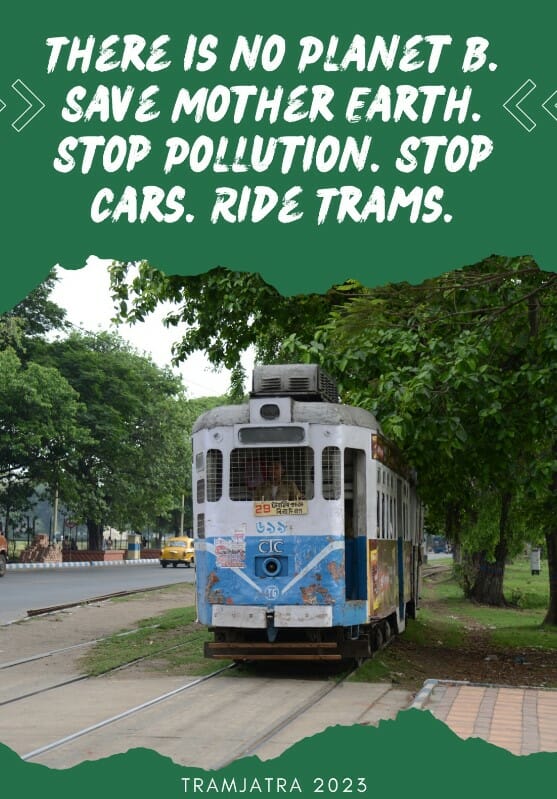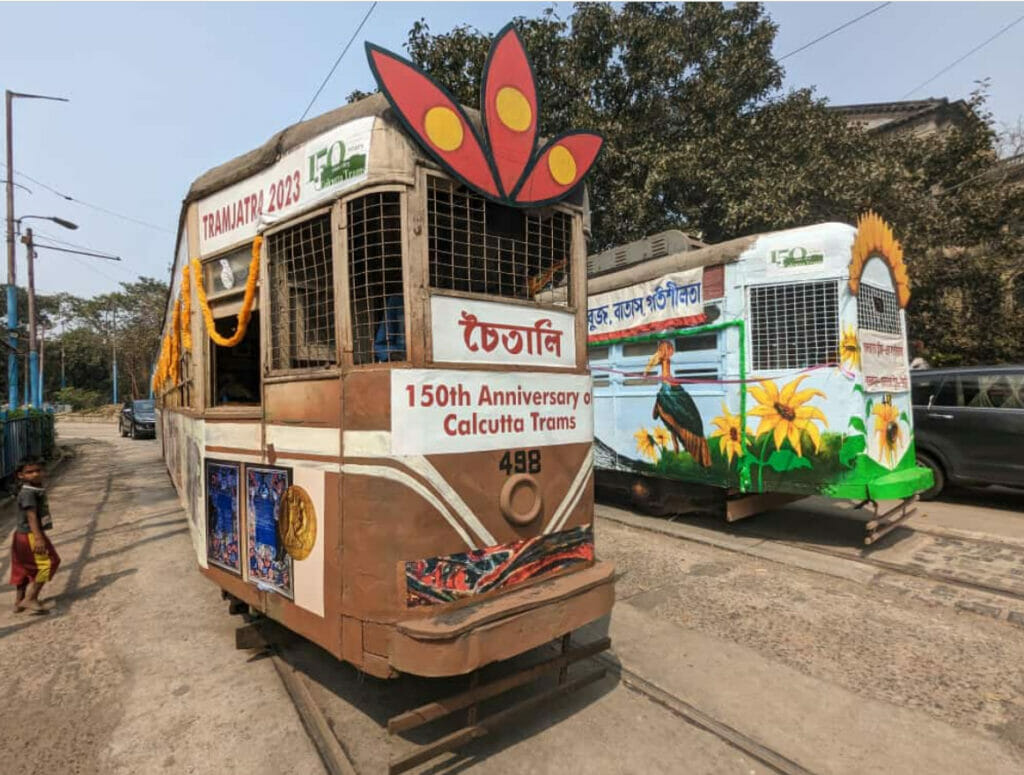“Trams still run on 40 routes in Melbourne with millions of users,” says former tram conductor Roberto D’Andrea, who along with his fellow conductor Tony Graham travelled from Melbourne to Calcutta in February to promote the five-day Tramjatra festival. “It is not merely a heritage ride but used daily by commuters as part of the public transit system”.
Calcutta is no Melbourne. But it can boast of two firsts: The first Indian city to build a metro line. And the only city to still have functional tram lines. The Calcutta metro of course gets all the attention and money. The trams now run purely as a reminder of Calcutta’s bygone era.
February marked 150 years since the first of the white, blue and sometimes yellow trams started rolling by in stately splendour. The network of tramlines can still be seen on the soft grass and cobbled streets of the city. Today, only three tram routes are functional. But more as a tourist attraction rather than as a possible addition to the city’s public transport system. Despite being both more eco-friendly and pocket friendly.
But even as opinion grows to phase out the trams, there is also a growing movement to try and revive them. These tram enthusiasts celebrated the tram system’s 150th birthday with pomp in the ‘Tramjatra’ festival.
A group of tram enthusiasts have united under the umbrella of Calcutta Tram Users Association (CTUA) to crusade for the dying trams and restore their glory. Group members have proposed several ideas to modernise trams and keep them running. These include creating designated platforms, synchronisation with school timings and introduction of tram routes as feeders to metro-lines.
In an interview with Citizen Matters, Dr Debashish Bhattacharya, President, CTUA, said, “The group has been advocating reinstatement of the tramways as an eco-friendly intermediate option between the inexpensive buses and the costly metros. Trams have an added advantage of having an exceptionally long service, ranging from 50-100 years.”
Read more: Delhi, Mumbai, Kolkata or Bengaluru – which megacity has the most toxic emissions?
Their plans however face several hurdles. “At a time when the importance of tramways is being discussed globally, they are being wiped out in India due to government corruption and public apathy,” says Dr Bhattacharya. “Citizens need to step up and take a united stand for the resumption of trams”.
The CTUA has been having awareness dialogues with the public, forming international links, and compiling research documents on trams, which are available on their official website.
An eco-friendly heritage
The electric tramcar first introduced in the early 1900s is a symbol of eco-friendly mobility in a city increasingly facing high vehicular pollution. Trams also don’t generate toxic battery waste like E-buses. Trams cause no noise pollution, nor do they encroach upon the city’s green areas for parking space.
Trams are also far cheaper in comparison to the metro. Their infrastructure is already laid down, so they do not burn a hole in the city’s coffers, like the new metro projects. They have low maintenance and running costs.

They have other unusual revenue earning uses too. Like heritage tours and even marriages on their coaches. In 2019, a joy ride was organized for 70 senior citizens under Kolkata Police’s Pronam project. Trams have also played a small but significant character in celluloid and literature. The shooting of “Detective Byomkesh Bakshy” saw a revival of a 1931 vintage double-bogie wooden tramcar.
But the fast changing cityscape in recent decades and the development of alternate transport modes dealt a heavy blow to tramways. The introduction of the metro corridor and construction of subways led to more and more tram lines becoming defunct.
The Howrah terminus was closed because the cantilever bridge could not support trams. In 2008 only 77,500 people reportedly travelled by trams. The downward spiral accelerated as commuter numbers dropped by 90%, even as the city population increased rapidly.
The glory days
The Calcutta Tramways Co. Ltd (CTC) was incorporated in London in 1880. Back then, the rail tracks were metre-gauge and tram-coaches were horse-drawn. Two years later steam locomotives were used to haul trams. By the turn of the century, CTC was a massive company owning 166 tram-coaches.
The 1900s saw the electrification of tramways and conversion of tracks to standard gauge. Several new routes were established. When Calcutta and Howrah were connected by tram through the Howrah bridge, the track length spanned 68 kms.
The tram then was the lifeline of the city, operating from the wee hours of morning till midnight which remained the case till the early ‘80s with tram service carrying 7.5 lakh passengers a day.
The trams even got a Smaranika museum in the Esplanade Tram Depot to commemorate the system. The museum displayed old tickets, badges, khaki uniforms, equipment and photographs, placed inside a 1938 built tram coach.
Phasing out
The arguments against trams are that they consume a lot of space in arterial roads, that they hold up traffic on account of their slow speed (averaging 35 kmph) and that their passenger carrying capacity is too low. In some places, the tramlines run opposite to traffic flow, creating chaos.
The tram, now seen as a slow and inconvenient mode of transport, also placed a heavy financial burden on the state. The entire system deteriorated to such an extent that Shyamal Chakraborty, former state transport minister planned to close the network entirely. But the government has been delaying the final decision fearing a public outcry.
A news article revealed that the government could no longer sustain running trams at a loss and the tram depots were being sold off to private business for real estate development. Attempts were made to secure a UNESCO tag for the trams which eventually fizzled out.
Several citizens have voiced their disappointment over the phasing out of trams. A long-time tram commuter laments that if tram services were stopped, people would have to journey in over-crowded buses or faraway metros. According to this tram fan, a modern city should give its citizens different options to commute, not take away from the available options.
In their turn, the CTC and West Bengal Transport Corporation (WBTC) tried a few measures to revive tramways. In 2013, the Nonapukur workshop manufactured two AC trams with television and radio facility to be used for heritage tours. WBTC also introduced a fine-dining AC tram from Esplanade to Khidderpore.
In 2019, a single-coach AC service was introduced between Shyambazar and Esplanade. It became a rave amongst passengers, with a cheap fare of Rs 20, raking thrice the revenue of the non-AC coach. The entire transformation cost only Rs 25 lakh.
A new lease of life or the end of the line?
Despite attempts at revival, the trams are losing out in a city where rapid transits are in demand. “Several tram routes have been shut down due to the ongoing East-West Metro construction,” said a senior WBTC official. “There are no new development projects for trams in the pipeline. Their future remains uncertain till the metro work continues. The AC tram too has been suspended citing metro work”.
The number of operational tram routes is today down to three from the dozen earlier. Services from the Gariahat and Esplanade depot have reduced in number and frequency. The Park Circus route has been closed down.
And getting a tram ticket requires a trip to the nearest tram depot on a specific date to get a monthly or all-day pass.
Tramjatra 2023

Since 1996, aficionados from Kolkata and Melbourne have collaborated to celebrate a moving tram carnival. On February 24th, a Tramjatra festival was held at the Esplanade terminus, to celebrate 150 years of service. The theme was Heritage, Green Mobility and Clean Air.
“Trams are our emotion and heritage and I am here today not to give farewell to the Kolkata Tram,” said transport Minister Snehasis Chakrabarty who was present at the event, “But due to increasing population and vehicles with no expansion of roads, it is difficult to run trams everywhere.”
Despite the regular dismantling of tram routes, the utility of trams stretches far beyond just heritage. It has the potential to make a comeback as a full-fledged mass transit system. Bhattacharya stresses the need to create “political pressure and reorient public opinion towards trams.”
Tram must start soon as it is a pollution free transport system